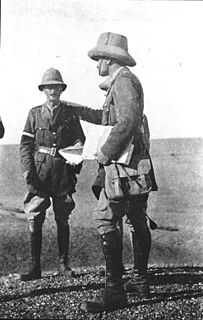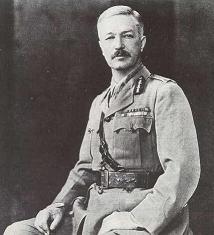 W
WBrigadier-General Arthur Edward Aitken was a British military commander.
 W
WField Marshal Sir Arthur Arnold Barrett was a British officer of the Indian Army. He saw action at the Siege of the Sherpur Cantonment in December 1879 and at the Battle of Kandahar in September 1880 during the Second Anglo-Afghan War and went on to serve in the Hunza-Nagar Campaign in 1891. During the First World War he was General Officer Commanding the Poona Division which successfully took Basra in Mesopotamia in November 1914 and then Al-Qurnah in Mesopotamia in December 1914. He spent the rest of the War commanding the Northern Army in which role he took part in operations against the Mahsuds in Spring 1917. He saw action again as the senior British officer on the ground during the Third Anglo-Afghan War in 1919 before retiring in May 1920.
 W
WGeneral Sir Alexander Stanhope Cobbe was a senior British Indian Army officer and a recipient of the Victoria Cross, the highest award for gallantry in the face of the enemy that can be awarded to British and Commonwealth forces.
 W
WBrigadier-General Edmund William Costello, VC, CMG, CVO, DSO was a British Indian Army officer and a recipient of the Victoria Cross, the highest and most prestigious award for gallantry in the face of the enemy that can be awarded to British and Commonwealth forces.
 W
WLieutenant-General Sir Walter Sinclair Delamain was an officer of the British Indian Army.
 W
WColonel Reginald Edward Harry Dyer, CB was an officer of the Bengal Army and later the newly constituted Indian Army. His military career began serving briefly in the regular British Army before transferring to serve with the Presidency armies of India. As a temporary brigadier-general he was responsible for the Jallianwala Bagh massacre that took place on 13 April 1919 in Amritsar. He has been called "the Butcher of Amritsar", because of his order to fire on a peaceful crowd. The official report stated that this resulted in the killing of at least 379 people and the injuring of over a thousand more. Some submissions to the official inquiry suggested a higher number of deaths.
 W
WGeneral Sir Malcolm Henry Stanley Grover was a general in the British Indian Army.
 W
WMajor-General Sir Patrick Hehir was a British military surgeon. He served in the Indian Medical Service (IMS) and as the Principal Medical Officer to the army of the Nizam of Hyderabad. During the 148 day Siege of Kut he suffered alongside the troops and wrote extensively on the topic of prolonged starvation.
 W
WField Marshal Sir Claud William Jacob, was a British Indian Army officer. He served in the First World War as commander of the Dehra Dun Brigade, as General Officer Commanding 21st Division and as General Officer Commanding II Corps in the Fifth Army. During the Battle of the Somme, his corps undertook the British attack during the Battle of Thiepval Ridge in September 1916 and the subsequent assault on St Pierre Divion during the Battle of the Ancre in November 1916. He remained in command of II Corps for the Battle of Passchendaele in Autumn 1917. After the War he commanded a corps of the British Army of the Rhine during the occupation there and then served as Chief of the General Staff in India. He went on to be General Officer Commanding Northern Command in India before temporarily becoming Commander-in-Chief, India and then taking over as Military Secretary to the India Office.
 W
WMajor-General Sir Alfred William Fortescue Knox was a career British military officer and later a Conservative Party politician.
 W
WBrigadier General Francis Aylmer Maxwell, was a British Army officer in the Second Boer War and First World War. He was also a recipient of the Victoria Cross (VC), the highest award for gallantry in the face of the enemy that can be awarded to British and Commonwealth forces.
 W
WGeneral Sir John Eccles Nixon was a senior commander of the British Indian Army. He gave the orders for the ultimately disastrous first British Expedition against Baghdad during the First World War.
 W
WSir Michael Joseph Tighe (1864–1925) was a British Army general who served in East Africa during World War I.